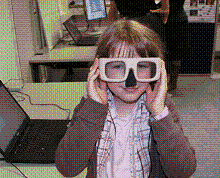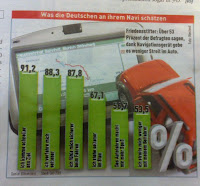 On Saturday we went to Garmisch and walked up to Höllentalklamm (a nice canyon) and had lunch at Höllentalangerhütter. Our GPS tracking data from the canyon was pretty poor (as one would expect as the canyon is in parts only a few meters wide).
On Saturday we went to Garmisch and walked up to Höllentalklamm (a nice canyon) and had lunch at Höllentalangerhütter. Our GPS tracking data from the canyon was pretty poor (as one would expect as the canyon is in parts only a few meters wide).
Observing other hikers (especially people who did the larger tours) it was very interesting to see how maps are used in social situations – planning, discussion, reflection, and storytelling (this time n>10). It is hard to image how this experience can be replaced by an implementation on a mobile device.
 Will we have to wait till we have 1 meter by 1 meter foldable e-ink displays with 200dpi? Or are there other means to implement a good hiking map on a mobile phone screen? There is a lot of ongoing research in this domain. For driving I would guess the paper map has been largely replaced by electronic devices – when will it happened for hiking?
Will we have to wait till we have 1 meter by 1 meter foldable e-ink displays with 200dpi? Or are there other means to implement a good hiking map on a mobile phone screen? There is a lot of ongoing research in this domain. For driving I would guess the paper map has been largely replaced by electronic devices – when will it happened for hiking?
 My guess is that traditional hiking maps will be the standard tool for another 10 years – obviously combined with a mobile device with GPS (e.g. phone, watch, or specific hiking GPS). There many ideas on how to do this – Johannes Schöning and Michael Rohs have worked on that for a while. The WIP they hat at CHI is an interesting example [1] or see the video on youtube.
My guess is that traditional hiking maps will be the standard tool for another 10 years – obviously combined with a mobile device with GPS (e.g. phone, watch, or specific hiking GPS). There many ideas on how to do this – Johannes Schöning and Michael Rohs have worked on that for a while. The WIP they hat at CHI is an interesting example [1] or see the video on youtube.
Projector phones are a hot topic – Enrico had some interesting work on interaction with projector phones at Mobile HCI 2008 [2] & [3]. I would expect that in a years time we will see quite a number of those devices on the market.
[1] Schöning, J., Rohs, M., Kratz, S., Löchtefeld, M., and Krüger, A. 2009. Map torchlight: a mobile augmented reality camera projector unit. In Proceedings of the 27th international Conference Extended Abstracts on Human Factors in Computing Systems (Boston, MA, USA, April 04 – 09, 2009). CHI EA ’09. ACM, New York, NY, 3841-3846. DOI= http://doi.acm.org/10.1145/1520340.1520581
[2] Hang, A., Rukzio, E., and Greaves, A. 2008. Projector phone: a study of using mobile phones with integrated projector for interaction with maps. In Proceedings of the 10th international Conference on Human Computer interaction with Mobile Devices and Services (Amsterdam, The Netherlands, September 02 – 05, 2008). MobileHCI ’08. ACM, New York, NY, 207-216. DOI= http://doi.acm.org/10.1145/1409240.1409263
[3] Greaves, A. and Rukzio, E. 2008. Evaluation of picture browsing using a projector phone. In Proceedings of the 10th international Conference on Human Computer interaction with Mobile Devices and Services (Amsterdam, The Netherlands, September 02 – 05, 2008). MobileHCI ’08. ACM, New York, NY, 351-354. DOI= http://doi.acm.org/10.1145/1409240.1409286







